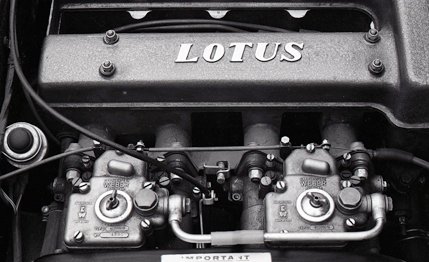Luggage? Well, better bring a trailer if you are taking a long trip, but there’s enough space in the trunk of the Elan for what any sports car owner would need for a long week-end. There’s also some space behind the seats which can be used for bags and brief-cases without inconvenience.
The ancestry of the twin-cam Lotus-Ford engine starts with the 997cc power plant of the new Anglia, the design of which began in 1954 and was introduced in 1958. This unit was known as the 105-E and was intended as the basis for a series of lightweight engines of various larger displacements. The first step was the 109-E which was used in the Ford Consul Classic. The enlargement from 997cc to 1340cc was made without any alteration in bore (80.96mm) but achieved entirely by giving the engine a new crankshaft with a longer throw, increasing the stroke from 48.41mm to 65.09mm. Both the 105-E and the 109-E had three-bearing cast crankshafts with hollow crank webs. A major redesign was put in hand for the 116-E; it was given a five-bearing crankshaft (with solid webs) and a new cylinder block with the identical 80.96mm bore but enough extra height to allow a stroke increase to 72.75mm, giving a displacement of 1498cc. The weight increase was only 15% for a 50% displacement increase over the original engine.
The 116-E became the basis for the Lotus twin-cam conversion. The block was bored out to 81.6mm while the stroke was kept at 72.75mm, giving a displacement of 1558cc. The light alloy twin overhead camshaft cylinder head was designed and developed by Lotus, not by Ford. The resultant engine was first used, in 1498cc form, in the Lotus 23 which made such a sensational debut at Nurburgring in 1962, and it became the power plant of the Lotus-Cortina that autumn.
Then Colin Chapman introduced the Elan, with the same engine but a different transmission from that used in the Cortina. The Elan transmission is a close-ratio version of the gearbox used in the new Ford Consul Corsair.
|
|
The task of designing the dohc head was complicated by the necessity of retaining as many Ford parts as possible, in the interest of keeping production costs down. Ford uses weight-graded pistons, which would be suitable for a high-performance engine, and it was decided not to replace them just to obtain a higher compression ratio. But with flat-topped pistons in a highly oversquare engine it is difficult to obtain a sufficiently high compression ratio for power outputs of competitive level to be reached. The solution was to use a quite narrow valve angle (54 degrees included) and letting the combustion chamber overlap the cylinder bore by 0.34 inches. This gave the engine a compression ratio of 9.5 to one, without any restrictions on valve size, gas flow or turbulence. The engine is redlined at 6500 rpm but is willing to rev to well over 7000. Peak power is developed at 5500 and maximum torque at 4000, but what is most surprising in this high-speed unit is that brake mean effective pressure never falls below 134 psi between 2000 and 6000 rpm. It is a unique combination of racing car and tractor engine and remarkably silent at all speeds.
Apart from the closer ratios, the only difference between the standard Corsair transmission and the one used in the Elan is the Lotus shift linkage. It’s an all-synchromesh four-speed but the synchromesh is not particularly effective on rapid changes and can be beaten on all gears.
The final drive is taken straight from the Ford Consul Classic and mounted in a Lotus-designed aluminum housing. This unit was of course intended for transmitting much less torque than the Elan engine puts into it, and we can only speculate as to its life expectancy. The final drive also tends to be noisy on the overrun.
|
|
Clutch action is as sudden as in a competition car. It immediately takes a tenacious grip and the car is under way. It’s possible to spin the rear wheels, first when moving off from standstill and again when shifting into second, but even in the absence of a limited-slip differential there’s no fishtailing. This type of clutch is great for lightning getaway at the traffic lights, and once one is used to its action, parking and maneuvering is no problem.
Aerodynamics of the Elan are very good, and we agree that the design is extremely clean and functional.
Its directional stability is certainly far superior to the rest of its weight class, and the car is quite acceptable for turnpike driving. Instead of the usual wind blast from the big trucks, there’s a gentle, controllable pressure which hardly calls for steering corrections.
In fact the sleek, small slipperiness of the car is its most endearing quality. The wonderfully soft ride combined with infinite controllability and tenacious road grip, the very low noise level linked somehow to so much solid power in a small displacement sports car, point up the very dual nature of the car. You used to have to put up with a lot to use a racing car on the street. Here’s one that can be expected to acquit itself well in club events with little change. The importers emphasize the opposite, that the car should not be raced without extensive preparation. But no matter what was done to prepare the car, you would give away little or nothing in creature comforts and tractability. We look forward to the next opportunity to drive one with the same feeling that makes skiers look forward to winter and kids look forward to vacations.
View Photos
View Photos


Leave a Reply